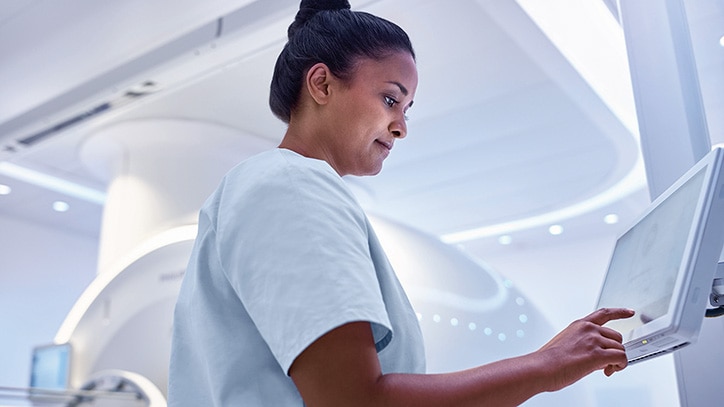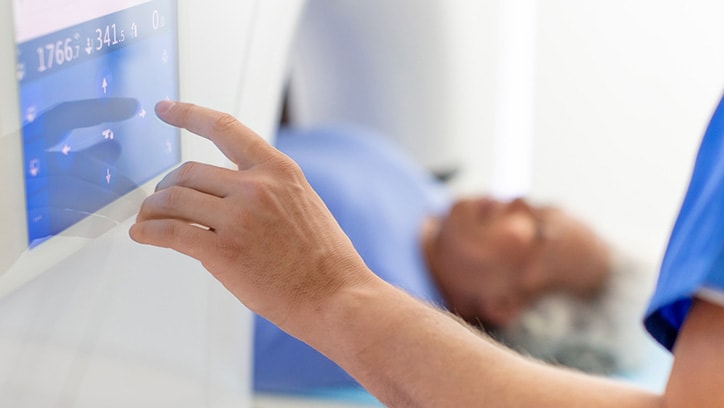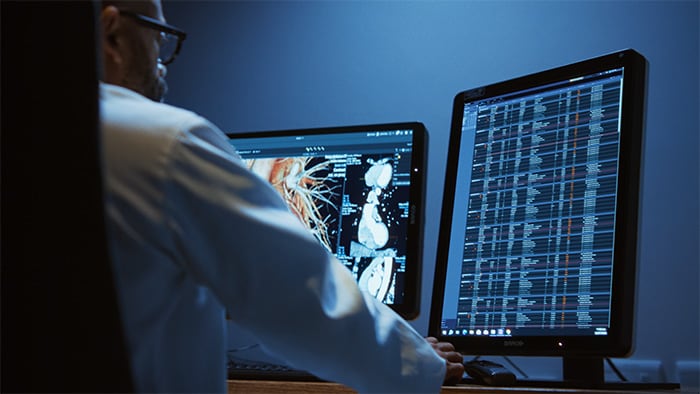Staff burnout in healthcare is growing. Can AI help ease the burden?
Apr 26, 2022 - Reading time 4-6 minutes
After a prolonged battle with the COVID-19 pandemic, healthcare providers now face the next crisis that has been brewing even longer: staff shortages and an increasingly exhausted workforce. In early 2022, almost one in two (47%) healthcare professionals reported feeling burned out, up from 42% last year [1]. Many consider leaving the field, adding to the worries of employers who see growing demand for care without enough hands at the bedside to cater for their patients [2]. Can AI be part of the solution by helping healthcare professionals reclaim the joy in their work?

The signs of a pending burnout crisis were already there before COVID-19 wreaked havoc with health systems worldwide. And the causes run deeper than the stress inflicted by the pandemic. In many ways, the past two years have magnified what was ailing healthcare professionals all along: the draining repetitiveness of routine tasks, a growing deluge of data that leaves them scrambling for relevant insights, and widespread frustration about workflow inefficiencies that get in the way of attending to patients. As one physician expressed in the 2022 Medscape Physician Burnout and Depression survey: "Where’s the relationships with patients that used to make this worthwhile?" [3].
Healthcare providers face exodus of staff
It should come as no surprise, then, that healthcare has been among the top three industries impacted by the Great Resignation, with many healthcare professionals quitting their positions to find improved work-life balance [4]. And for healthcare organizations facing increased turnover, the worst may be yet to come. According to a new study by the American Medical Association, one in five physicians and two in five nurses intend to leave their current practice within the next two years [5].
As a result, staff shortages are now the number one concern keeping American hospital executives up at night [6]. Other countries around the world – from the UK and Germany to Singapore and Australia – are seeing a similar exodus of healthcare professionals, fueling fears about the potential impact on quality of care [7,8,9,10].
Simplifying workflows through AI-based automation
What we’re witnessing is an increased urgency to liberate healthcare professionals from the strain of tedious and repetitive tasks, so that they can focus on what drew them to medicine in the first place: caring for patients. It’s exactly what AI can help to make possible. By shifting the burden of tedious manual work from human to machine, AI allows healthcare professionals to apply their time and energy to the patient rather than to cumbersome processes.
Take medical imaging technologists, for example. Ranked #2 by hospital CEOs as the profession that is seeing the largest shortage of qualified staff [11], technologists have the daily challenge of achieving best-quality, first-time-right scans, with high workloads being the #1 contributor to job-related stress [12]. Patients are often anxious, too, which adds to the pressure on technologists to get the exam done effectively. Variability in training and experience levels of staff can further impact outcomes.
By automating many of the time-consuming tasks that technologists traditionally had to perform manually, we can free up their focus to interact with the patient, while improving consistency of results at the same time. Research shows that imaging staff welcome such support from technology – they believe that almost a quarter (23%) of their work is inefficient and could be automated [13].

Getting the patient in the right position for an exam is a case in point. In an imaging modality like CT, patient mispositioning is a common challenge, with unwanted consequences such as increased radiation dose to the patient or image noise [14]. That’s where new AI-enabled camera technology can make a difference. Mounted on the ceiling above the patient table, the camera uses algorithms that can automatically detect anatomical landmarks in the patient, supporting fast, accurate and consistent patient positioning.
Smart and touchless patient sensing technology is also saving technologists manual work in MR imaging, where it can automatically monitor a patient’s breathing – allowing the setup of routine MR exams to occur in less than a minute [15], even for less experienced operators, while helping them keep a caring eye on the patient. In addition, smart AI-enabled systems can suggest the most appropriate protocol for each MR exam, as well as automate exam planning, scanning, and processing.
Thanks to such AI-based automation, technologists have to worry less about equipment settings and can dedicate more attention to the patient, making their work less stressful and more rewarding.
Providing relevant insights at scale at the point of care
In the face of growing information overload, AI can also ease the burden on healthcare professionals by supporting them with relevant insights at the point of care.
For example, one of the biggest challenges facing critical care teams in intensive care units (ICUs) is the sheer volume of data collected on every patient. Each patient in the ICU may generate up to thousands of data points per day, leaving physicians and nurses feeling overwhelmed as they struggle to separate signal from noise [16].
Using predictive analytics, we can help critical care teams cut through the clutter by alerting them to relevant trends in patient data that call for urgent intervention, or which may indicate that a patient is ready to be transferred to a lower-acuity setting. The physician or nurse remains in control of all decisions. But with the support of AI, they may be able to make these decisions more easily.

In the future, AI-enabled patient monitoring solutions will increasingly be extended from the hospital into the home, allowing healthcare providers to keep a caring eye on patients and thereby prevent avoidable hospital (re)admissions. This could alleviate some of the pressure on overstretched emergency and critical care teams, while also giving patients greater peace of mind in the comfort of their homes.
The need for human-centered AI
Of course, technology can only be one part of effective staff retention and burnout mitigation strategies. But as these and other examples demonstrate, AI could go a long way towards enhancing the human experience in healthcare – both by improving workflow efficiencies and by augmenting clinical expertise.
Most importantly, to curb burnout and revive the joy in medicine, we need to ask how we can develop digital tools that support the patient-provider relationship rather than get in the way of it. Studies have consistently shown that lack of workflow integration is one of the main barriers to wider adoption of AI in healthcare, pointing to a need for human-centered design.
By putting people front and center, we can develop AI-based solutions that act as an unobtrusive assistant, supporting healthcare professionals at a time when they are under more pressure than ever before. Because if there’s one truth that the growing staffing and burnout crisis in healthcare is bringing to the fore, it’s that there is no healthcare without healthy and engaged healthcare professionals.
References
[1] https://www.prnewswire.com/news-releases/medscape-physician-burnout--depression-report-2022-shows-pandemics-continued-impact-301465333.html
[2] https://www.sciencedirect.com/science/article/pii/S2542454821001260
[3] https://www.prnewswire.com/news-releases/medscape-physician-burnout--depression-report-2022-shows-pandemics-continued-impact-301465333.html
[4] https://www.bls.gov/news.release/jolts.nr0.htm
[5] https://www.sciencedirect.com/science/article/pii/S2542454821001260
[6] https://healthexec.com/topics/healthcare-administration/hospital-ceos-workforce-shortages-challenging
[7] https://www.theguardian.com/society/2022/feb/26/stressed-nhs-staff-quit-at-record-rate-of-400-a-week-fuelling-fears-over-care-quality
[8] https://www.iamexpat.de/career/employment-news/germanys-shortage-nursing-staff-continues-worsen
[9] https://www.smh.com.au/national/pandemic-triggers-mass-exodus-of-critical-care-nurses-20211116-p5998i.html
[10] https://www.straitstimes.com/singapore/politics/more-healthcare-workers-in-spore-resigning-amid-growing-fatigue-as-covid-19-drags
[11] https://healthexec.com/topics/healthcare-administration/hospital-ceos-workforce-shortages-challenging
[12] https://www.usa.philips.com/healthcare/medical-specialties/radiology/improving-radiology-staff-and-patient-experience/staff-research
[13] https://www.usa.philips.com/healthcare/medical-specialties/radiology/improving-radiology-staff-and-patient-experience/staff-research
[14] Habibzadeh MA, Ay MR, Asl AR, Ghadiri H, Zaidi H. Impact of miscentering on patient dose and image noise in x-ray CT imaging: phantom and clinical studies. Phys Med. 2012;28(3):191-199. http://doi:10.1016/j.ejmp.2011.06.002
[15] Based on in-house testing. Results may vary.
[16] https://hbr.org/2018/03/how-mayo-clinic-is-combating-information-overload-in-critical-care-units









